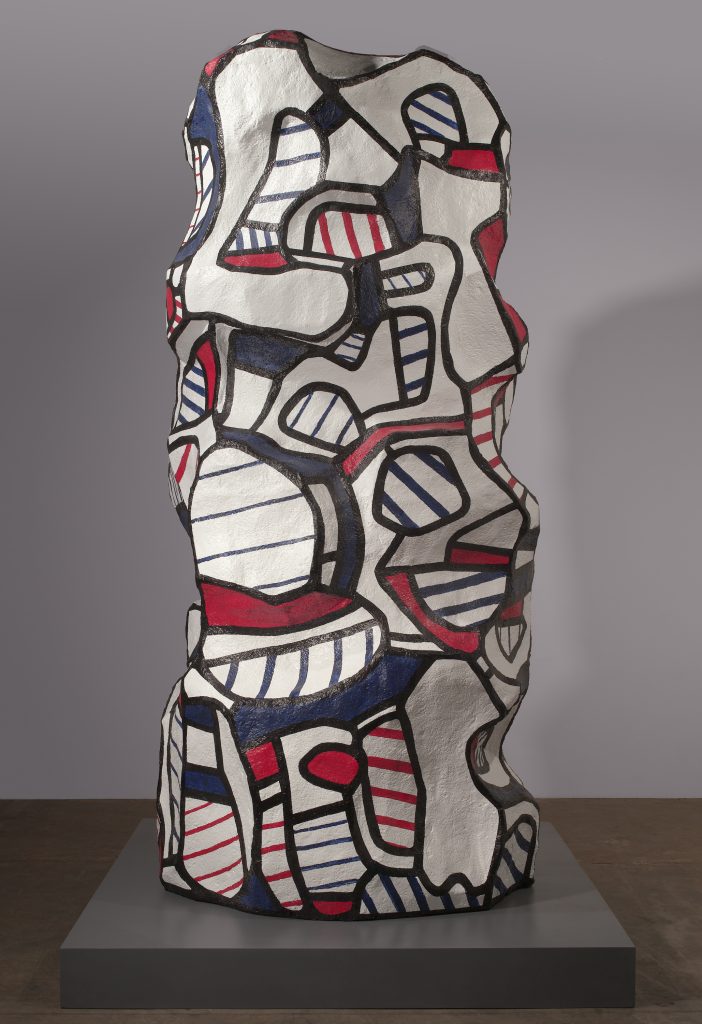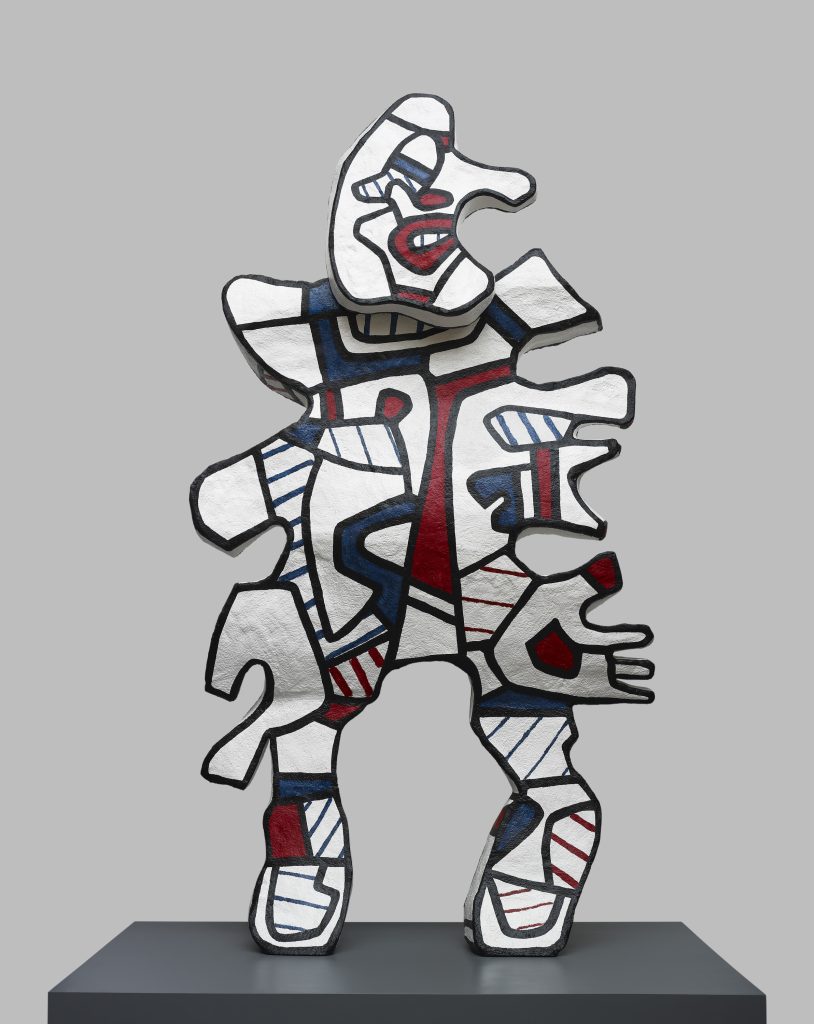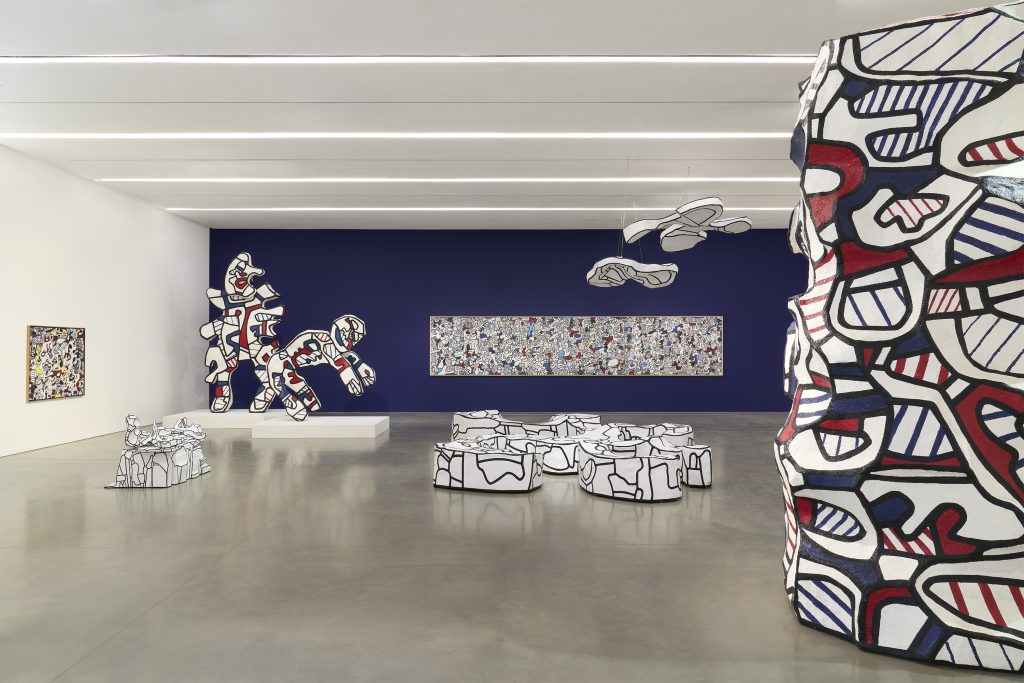Frankly, I am captivated by the art from the late, well-known modern artist Jean Dubuffet that’s in his “Hourloupe” cycle, a series of artworks created over more than a decade that is the focus of a new exhibition at Pace in New York.
The cycle and exhibition include both painting and sculpture. The sculptures in Pace’s invigorating show are comprised of polyurethane paint on epoxy, which together make the pieces look caught in some moment or process of transfiguration or growth, like a caterpillar rearranging itself into a butterfly or that instant before the sun fully rises when it’s visibly almost, nearly there, and when it looks like night and day are existing at the same time.
The textures, which in the sculptures are rough but uncertain of themselves and not so confrontational, and these environments are a distinct and familiar place, but they’re not exactly what you anticipated. They don’t exactly mesh. The sculptures across this exhibition posit a transitional, developing state for something that’s ordinarily so taken for granted as the relationship between a person and a touched, physically sensed object. It’s all becoming something new.
As seen at Pace’s show, Dubuffet transformed and developed space in the context of both these sculptures and the captivating paintings, all of which are united by patterns of interlocking and interlacing forms, curving but quietly assertive. The forms — distinct and memorable — look organic and expressive, like an imprint of biological life beginning to take flight and morph into a new, more independent beast, something beyond perceptual and sensory expectations.
Those forms, in how they seem to expand assertively across each surface where they appear, feel bodily, but individually and in totality, they only visually resemble such a thing in the vaguest, loosest sense. Instead, it’s more like a pattern of change building atop itself and becoming more than itself… an endless pattern, a circulating and recirculating spatial interdependence. Suddenly, each moment and glimpse of spatial grounding is leaning on and building up the next one, fundamentally subverting the object independence that I think some conventions of perception lead to be an assumption.
Instead, in Dubuffet’s art from this cycle, these sprawling moments of spatial reckoning become not even just a narrative but a unity: an entire, singular story, whether building up more dramatically or less so. Everything you can see and sense is now existing together.
Dubuffet coaxed out a feeling of light thanks largely to enriching formal interaction (plus plenty of white in the palette). These artworks consistently feel just incredibly lit. And yet, though some of the work does more obviously nod to the world’s three-dimensional confines, none of it is directly and entirely representational. So, where does the light originate? Somewhere that’s outside of what we’re used to. The art asks us to consider these things as a winding, unfurling relational state as much as they’re a physical constant.
In this art, encountered space becomes perhaps primarily a questioning of that encounter… a fluid and changing place that will be substantively different each time you look over, noticing something new. There’s so much in some of these artworks that they become a journey of endless newness rather than a fixed spread of points and ideas. You’re always seeing something new!
The tangible and materialized become something simultaneously elevated and spiritual: distinctly what they were originally but now also this initially exterior thing. Transition becomes the key state of being rather than an outside, separate, or unknowable process. In the art, the esoteric and spatially intermingling are maybe not knowable and cognizable in the traditional sense, but they’re at least viewable, visible… a visual impression that is actively transcending its status as an image to also become a spatial elucidation.
There is no end anywhere in any of these artworks. The lines of Dubuffet’s ambitious, engaging imagery circle back into themselves and into the next ones over and over again, and in the lack of an end, a new, holistically encompassing, visual whole forms. It is a manifestation of consistency, of continuance, of elevation as a state of being rather than a sequence. It’s an endlessly new, refreshing plane. Everything that we are looking at exists outside of time as a progression and yet retains the essence of itself that originally grounded it anywhere, now grounding it to itself, grounding it to the process of itself: the transition, the development, the growth, and the movement.
And all of this is very systematic in scope. It establishes an elevated sense of place and proves enveloping. The art by Dubuffet showcased here moves easily between an impression of inhabited body, object, and environment, all of it somehow melding into a continuum and sitting within… not the future, but the next, the other — right while you’re looking at it.
“Jean Dubuffet: The Hourloupe Cycle” continues at Pace in New York City through April 26.



Featured image:
Jean Dubuffet: The Hourloupe Cycle
540 West 25th Street, New York, NY 10001
March 13 – April 26, 2025
Photography courtesy Pace Gallery
You may also like
-
Diana Kurz at Lincoln Glenn in New York: A Review of a Shining Art Exhibition
-
Dustin Hodges at 15 Orient in New York City: An Ensnaring Exhibition at an Exciting Gallery
-
Maren Hassinger at Susan Inglett Gallery in New York: Reviewing an Uplifting Art Exhibition
-
Enzo Shalom at Bortolami in New York City: Reviewing an Entrancing Exhibition of Paintings
-
“Ben Werther: Townworld” at Amanita in New York City: Reviewing a Richly Memorable Art Exhibition
